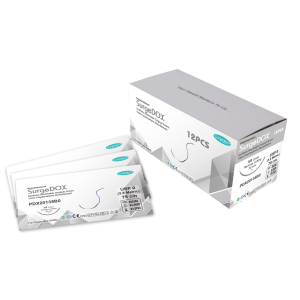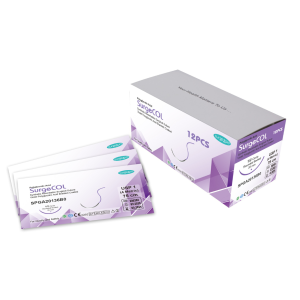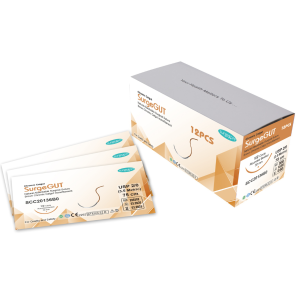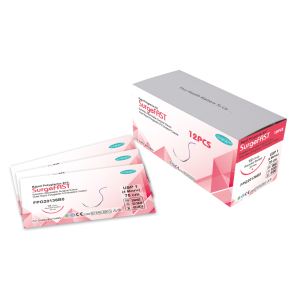Description
Suture Substance Suture Substance
The Polyglactin 910 suture by Surgexon is a sterile, synthetic absorbable surgical suture. It is composed of copolymers derived from 90% glycolide and 10% L-lactide. The Polyglactin 910 suture is offered in either violet or colorless variations, and it is available in sizes ranging from USP 8-0 to USP 2.
Polyglactin 910 suture produced by Surgexon complies with the standards set by the United States Pharmacopeia (USP) and the European Pharmacopoeia (EP) for Synthetic Absorbable Surgical Sutures. It fulfills all the requirements specified for such sutures, with the exception of occasional oversizing in certain gauges.
Instructions for Use Instructions for Use
The Polyglactin 910 suture is specifically recommended for general soft tissue approximation and/or ligation purposes. It can be utilized in various surgical procedures, including ophthalmic surgery. However, it is not intended for use in cardiovascular or neurological tissues.
Actions Actions
The placement of Polyglactin 910 sutures in tissue may result in mild tissue inflammation, which is a typical foreign body response. This initial response is subsequently followed by the gradual encapsulation of the sutures by connective tissue. Afterward, the absorption process begins through hydrolysis, where the polymer breaks down into glycolic acid, which is then absorbed by the body.Polyglactin 910 sutures induce a minimal acute inflammatory response in tissues, and then the sutures are gradually encapsulated by fibrous connective tissue.
The process of Polyglactin 910 suture absorption involves a gradual decrease in tensile strength and is ultimately absorbed through hydrolysis. During hydrolysis, the polymer breaks down into glycolic acid or a combination of glycolic and lactic acids. These breakdown products are subsequently absorbed and metabolized by the body.
The absorption process of Polyglactin 910 absorbable synthetic sutures initiates with a gradual decline in tensile strength, while the mass of the suture remains relatively unchanged.
By approximately 5 weeks after implantation, the sutures experience a complete loss of their original tensile strength. The absorption of Polyglactin 910 sutures is considered mostly finished between 56 and 70 days’ post-implantation.
Characteristics Characteristics
Polyglactin 910 sutures are coated to enhance their properties as a smooth and easily passable synthetic absorbable suture.
The benefits of using coated Polyglactin 910 sutures include:
- Facilitated passage through tissue
- Accurate placement of knots
- Smooth and secure tying of knots
- Reduced likelihood of tissue irritation
- Increased tensile strength
- Extended absorption period
Indicators Indicators
It is important not to reserialize Polyglactin 910 sutures. Open and unused sutures should be discarded. These sutures should be stored at room temperature and protected from prolonged exposure to high temperatures.
Furthermore, like any foreign body, if these sutures come into prolonged contact with salt solutions found in the urinary or biliary tracts, there is a risk of calculus formation (the formation of stones).
Before using the Polyglactin 910 synthetic absorbable suture for closing wounds, it is important for users to have knowledge and understanding of surgical procedures and techniques related to absorbable sutures. This is necessary because the risk of wound dehiscence can differ depending on the location where the suture is applied and the specific material of the suture.
- Proper adherence to acceptable surgical practices is essential when it comes to draining and closing contaminated or infected wounds.
- The utilization of this suture may not be suitable for elderly individuals, malnourished individuals, debilitated patients, or those with conditions that may cause delays in the healing of wounds.
- It is important to refrain from reusing single-use devices. Reusing these devices can lead to cross contamination and compromise the safety, performance, and effectiveness of the device. Such practices can unnecessarily expose patients and staff to risks. The design and materials of these devices are not compatible with standard cleaning and sterilization procedures.
Precautions Precautions
• It is crucial to exercise caution when handling Polyglactin 910 Sutures, taking special care when dealing with the needle to prevent any damage caused by needle holders. Users should possess adequate knowledge and familiarity with absorbable Surgical Sutures and their gradual decrease in tensile strength before engaging in the handling of Sutures.
• In certain situations, particularly during orthopedic procedures, the surgeon may choose to use external support for immobilization.
• Skin sutures that need to stay in place for more than 7 days may lead to localized irritation and should be either snipped off or removed as necessary.
• When handling this suture material or any other, it is important to handle it with care to prevent damage. Avoid applying excessive force or pressure that could lead to crushing or crimping damage, especially when using surgical instruments like forceps or needle holders.
• To ensure sufficient knot security, it is necessary to employ proper surgical techniques, such as using flat, square ties. Additional throws may be required based on the surgical situation and the surgeon's experience.
Adding extra throws may be especially suitable when tying knots with monofilament sutures. However, it is important to note that Polyglactin 910 is not recommended for use in elderly or debilitated patients, as well as patients with impaired wound healing. Tissues with inadequate blood circulation may reject the suture material due to its delayed absorption.
Brand Name Length Size
| Brand Name | Suture Material | Length | Size | |||||||||||
| SurgeCRYL | Polyglactin910 |
|
|















